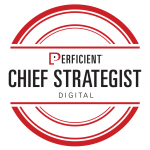Delivering seamless, consistent, and engaging experiences starts with a customer-centered digital strategy. This ongoing series explores the characteristics that make up a great digital strategy and how to deliver powerful brand moments that solidify customer loyalty and drive differentiation for your organization.
Earlier in this series, we revealed the importance of organizational alignment for your digital strategy. My colleague, David Stallsmith, summed it up nicely: “It is the core of your strategy, the backbone of your business, and an accelerator of what you hope to achieve.” But getting your teams and departments focused on the customer and digital mission is just the beginning. Once you have them rowing in the right direction, there is more to consider to get them working together to max out their digital potential.
Organizational alignment paves the way for lean transformation. Furthermore, lean transformation is uniquely important and relevant for driving customer centricity. To deliver customer-focused innovations, it’s important to understand the elements of lean transformation and how to overcome the foreseeable challenges.
What Is Lean Transformation?
Lean methodology originated in manufacturing during the mid-twentieth century. It was the innovative idea that revolutionized Toyota’s production system, and modernized manufacturing and ultimately operational capabilities around the globe in every industry. The methodology defines value from the customer’s viewpoint, focuses on improving processes while eliminating waste, and ultimately boosts innovation.
Lean transformation builds on this methodology to lay out a blueprint of organizational tools and approaches. Fusing Design Thinking with Agile, we define lean transformation as an organizational change to how we design, build, and run digital, customer-centric systems.

Perficient Digital’s Design Thinking Methodology
Why Embrace Lean Transformation?
There are a few good reasons to embrace Lean principles in your organization, regardless of whether or not you’re motivated by digital, or customer experience, or another reason to build operational excellence into your organization. But digital customer experience is an ideal place to adopt lean transformation for a couple of key reasons.
First, digital projects focused on customers thrive when teams tap into the human elements that make digital solutions more useful, usable, and impactful. Technology projects have historically attempted to incorporate user requirements in various formats (and with typically painful outcomes). Lean organizations address this by incorporating customer empathy and a range of stakeholder inputs from a holistic team with diverse perspectives.
Second, the expectations of IT and the CIO’s role in the organization have shifted. For years, IT teams have built and managed systems for scale and predictability. But in today’s customer-centered world, it’s not enough to keep the lights on. CIOs are now entrusted with helping their companies meet customers’ changing needs and react to competitive threats with the same systems (and funding) they’ve always had. Customer-centered organizations have adopted lean principles to augment scale and predictability with agility and speed.
[perfectpullquote align=”full” bordertop=”false” cite=”” link=”” color=”” class=”” size=””]”Customer centricity is the permanent result of technology disrupting the relationship between consumers and brands.”[/perfectpullquote]
Six Elements of Lean Transformation (and Why They Matter)
1. Iterative delivery
Waterfall, big-bang efforts are fundamentally flawed because none of the risk is confirmed until the very end. Your team may wonder: “Are these the right features? Will this technology even work?” When the proverbial veil is lifted, it’s too late to make significant changes.
Iterative projects solve many of these flaws. You create an environment to test and re-evaluate all aspects of the project early and often. Doing so allows you to expose the risks sooner, giving you time to react and adjust. Then, you can focus your limited time and budget on what matters most.
2. Continuous testing
Well-intended iterative projects simply turn into incremental projects when testing is not built into each iteration. Our best client projects have proven that testing different aspects – from the customer journey and basic user experience to tricky system integrations and the final, working solution – is the most effective way to derive feedback and uncover the right solution.
Being test-driven goes beyond scheduling ample time for testing activities. You also must consider testing tools, data, content, methods, and participants.
3. Research-based decisions
Customer centricity is the permanent result of technology disrupting the relationship between consumers and brands. The first rule of customer centricity is knowing your customers – who they are, what they want and need, and why they choose you. Observation, studies, and behavioral analytics are key tools for researching and understanding your customers.
At the broadest, contextual level, basic customer insights are table stakes for a design thinking approach. If you have this insight, then large-scale research isn’t needed for every project.
In a typical project where the customer is well known, user research still happens, but it’s essentially reduced to feedback and the results of your testing. When the problem domain is new or particularly unique, then smaller amounts of focused research may be necessary to lay the groundwork.
4. Prototyping
At the heart of Agile, iterative methodologies are the ability to test your work and run experiments so we can use those results and feedback to drive the product. But long before the product takes form, we use prototyping to create something to run our tests and experiments against. Simple, low-fidelity, pencil-and-paper prototypes are amazingly effective early in projects, and more comprehensive, high-fidelity prototyping tools (e.g., Adobe XD and InVision) are now more economical than ever.
Strong design thinking teams think about prototyping tools and strategies at the start of their projects. Think outside the box with prototyping. Storyboards, animation, and video are also extremely effective ways to communicate the breadth of your project. More advanced product teams invest in platform stubs and virtualization to extend prototyping even further.
5. Cross-functional teams
Digital ecosystems can be complex with many interdependencies. At the same time, customers can be unpredictable and inconsistent. Combine these challenges, and your business faces compounded risk and uncertainty.
That’s why strong digital teams should consist of holistic, cross-functional team members. You’ll want a team that brings a complete skillset but also a variety of perspectives, experiences, and objectives to balance the risk and complexity of digital projects. This includes customer-centered design, versatile engineering, and strong business input. We call this concept the Minimum Viable Team (MVT). When coupled with its product counterpart, the Minimum Viable Product (MVP), these are two strong moves to adapt digital and non-digital teams.
6. Product-oriented development
In some organizations, a product-oriented approach to design, engineering, and servicing systems as distinct products can simplify the overall complexity. This approach also establishes focus for your business so that you organize processes and teams chartered with delivering these products.
Product orientation encourages multiple teams to work independently and helps govern interdependencies and priorities through coordinated, release-driven planning. This approach requires advance thinking about an overall product architecture – usually defined by customer segments, channels, and features – and thinking through Service Level Agreements (SLAs) among product teams and constituents.
Conquering Obstacles for Lean Transformation
Organizational inertia
One of the toughest obstacles to becoming Lean is the simple resistance to change. We encourage small steps with adequate training, education, and leadership mandates to gain cooperation and buy-in across your organization. But most of all, you must prove that these elements will work for your organization.
Overcoming this mindset can be addressed with an organizational change management (OCM) strategy adapted for your digital program. OCM should also be considered for ongoing governance and oversight activities.
Another option is to create a Digital Center of Excellence (COE) or similar model to provide support, education, and shared services. With a design thinking team that’s starting from scratch, you’ll have to create a design system that enables a variety of tools – personas, customer journeys, low- or high-fidelity prototyping, or simulation tools. Your team will also have to build customer empathy and develop design standards. This pre-work must be done to lay the groundwork for lean transformation.
Scheduling woes
Scheduling and managing distributed resources from multiple teams can be nearly impossible, particularly when those resources are shared among other projects. The most effective response is to construct dedicated product teams, ideally in a co-located workspace dedicated to the product mission.
Establish a MVT that consists of a product owner, business owner, engineers, testers, and designers. Pulling them together and dedicating them to the project brings the combination of holistic perspectives, the chance to bond as a team, and the dedicated time to make progress.
However, this solution may be radical for some organizations because it alters career planning, challenges centralized controls, and can appear expensive for part-time commitments. Rest assured, the payoff is much improved teamwork and communication with the lack of distractions and minimal wait times.
Maintaining diversity of thought
Diverse perspectives bring real value to designing digital products. Diversity encompasses individuals from different demographics or socioeconomic backgrounds, but it also includes bringing in resources from different industry categories, skill areas, or teams.
Diversity of thought makes it possible to break the organizational inertia and build empathy with different audiences. Consider the airline industry for a moment and the apps developed for passengers. Do any of them stand out? There’s little differentiation between them. This exemplifies the need for diversity among a design thinking team. When you have a group of people with similar traits and backgrounds writing the software, the end result is undifferentiated products.
Lean Transformation Bolsters Innovation
Innovation happens across a wide spectrum, from the truly disruptive to the quietly sustainable.
Sustaining innovations tend to be internally focused, helping you work faster, exploit existing strengths, and build operational excellence. At the other end of the spectrum, disruptive innovations focus on growth, explore new territory, and tend to enhance the customer experience.
Disruption gets the attention, but sustainable innovations can be equally valuable in terms of competitive advantage. We’ve found that Lean teams bring the most balanced, holistic perspective to finding the right balance of innovation.
Start small, fail fast, prove success
The best innovative approaches embrace failure as a core value. While that may sound counterintuitive, the premise is really this: what can you learn from failure?
Creating an environment for continuous testing and learning is among the primary traits of highly-effective and innovative companies. Experimentation, testing, and learning are key to reducing risk and taking full advantage of the insights gained as you innovate.
You can prove success by starting with a small project, run by a capable team that is committed to the process. Once you prove success with these methodologies, others in your company will want to do the same.
The Key Takeaway
Why should your organization be Lean? Because change is the only constant. Customers and their preferences continue to evolve. The technology continues to change, and therefore, businesses must always be ready for change. By incorporating the elements of lean transformation, your business – the teams and technologies – can quickly adapt and respond to these realities.
Creating stand-out digital customer experiences that attract, engage, and retain customers is a tall order. Perhaps you’ve already done some of the foundational work, and you need help with the next step.

When working with clients, we help make sure you know your customers and understand their journeys. Through design-thinking tools, industry research, and pragmatic ideation to execute from end-to-end, you will have what it takes to deliver experiences that surprise and delight your customers.
Ready to get started with your digital strategy? Dive in for more resources.

